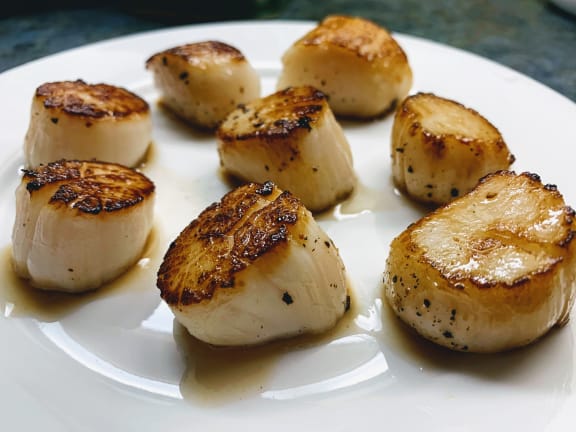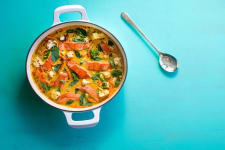A variety of cooking methods can bring out the incredible qualities of sweet, weathervane scallops from Alaska. They’re naturally tender and moist, so they’re easy to cook — as long as you understand how to prepare them. Whether you enjoy a golden crust or prefer the delicate, succulent texture of steamed foods, here are the best ways to cook scallops at home.
How to Cook Scallops: Best Methods
Depending on your preference, scallops can be seared, broiled, air fried, baked, or steamed. Searing will produce the most dynamic texture in the scallops, while baking or broiling may be the best methods for cooking for a crowd.
Tips for Cooking Scallops Perfectly
-
Always pat scallops dry before cooking them. This will ensure the best texture and flavor once they’re cooked.
-
Choose dry packed scallops. “Wet packed” or “wet” scallops are treated with chemical additives that can negatively affect the flavor and texture of scallops. “Dry packed” or “dry” scallops are untreated and all natural, which makes them easier to cook.
-
Don’t crowd scallops in a pan. Regardless of which cooking method you use, it’s best to leave room between the scallops for heat to circulate and steam to escape. Cook in batches if necessary.
How to Sear Scallops
Searing is the best cooking method for scallops when you crave a golden, restaurant-style crust. It’s also one of the fastest ways to cook them.
-
Heat a cast-iron or stainless steel skillet over high heat. While the pan is heating, pat the scallops very dry and season evenly with salt and pepper.
-
Add just enough oil to cover the bottom of the pan. Then allow the oil to heat until it begins to shimmer, about 1 to 2 minutes.
-
Carefully place scallops into skillet, placing them about 1 inch apart to allow steam to escape. Do this in batches if necessary.
-
Sear scallops undisturbed until a crust forms on one side, about 2 to 3 minutes. Flip carefully and cook on the other sides for 30 seconds to 1 minute, depending on size.
-
Transfer cooked scallops to a serving platter and serve immediately.
How to Broil Scallops
For high-heat, low-maintenance cooking, try broiling your scallops. There’s no flipping involved, and the broiler will add some texture to the surface of the scallops as well as some charred flavor.
-
Set an oven rack 4 to 6 inches away from the broiler element. Preheat broiler to “high.”
-
Pat scallops dry and place in a shallow baking dish or cast-iron pan in a single layer, placing each scallop about 1 inch apart.
-
Broil scallops in the oven until they begin to caramelize and turn golden, about 6 to 8 minutes.
-
Remove from the oven, season with salt & pepper and serve immediately.
How to Bake Scallops
Baking scallops can make it easier to cook a large quantity for a crowd. You won’t need to flip them — and while you’re waiting for the scallops to cook through, you’ll have plenty of time to prepare the rest of your meal.
-
Preheat oven to 400F
-
Pat the scallops dry and place in a shallow baking dish or cast-iron pan in a single layer, placing each scallop about 1 inch apart. Season evenly with salt and pepper.
-
Bake scallops in the oven until they begin to caramelize and turn golden, about 18 to 20 minutes.
-
Remove from the oven, serve immediately.
How to Air Fry Scallops
Cooking scallops in an air fryer is a simple way to add dynamic texture, effortlessly. Make sure you leave plenty of room between scallops when using this method, no matter how small your air fryer basket is.
-
Preheat air fryer to 400F.
-
Pat the scallops dry and place in air fryer basket lined with parchment in a single layer, placing each scallop about 1 inch apart.
-
Air fry the scallops until they begin to caramelize and turn golden, about 8 to 10 minutes.
-
Remove from the air fryer, season with salt & pepper, and serve immediately.
How to Steam Scallops
Steamed scallops will be especially moist in texture, but compared to other cooking methods may not be as flavorful — so the addition of a sauce is recommended.
-
Prepare a small steamer or steamer basket and a saucepan with 2 inches of water and bring to a boil on the stovetop. While the water is heating, pat the scallops dry and season evenly with salt and pepper.
-
Place scallops in the steamer setup in a single layer, making sure to leave some space between each scallop to allow steam to escape.
-
Reduce heat to medium, cover and steam scallops for 8 to 10 minutes, until scallops are cooked on the outside, but still soft and tender in the middle.
-
Transfer to a platter and serve immediately.
How to Cook Scallops FAQs
How long to cook scallops?
Depending on the cooking method, scallops can cook in as little as 3 minutes or require up to 20 minutes.
What is the best way to cook scallops?
A variety of cooking methods can be used to cook scallops. If you like texture, you may prefer searing or air fryer. For ease, you may prefer baking or broiling.
How do you know when scallops are done?
Weathervane scallops are done when they just turn opaque through the center. If cooked past this point, they may start to become tough in texture.
Can you cook scallops from frozen?
For the best texture and flavor, it is not recommended to cook scallops from frozen. Defrost scallops before cooking. You'll have much better results when thawing them first.






